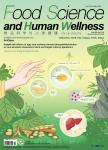版权所有:内蒙古大学图书馆 技术提供:维普资讯• 智图
内蒙古自治区呼和浩特市赛罕区大学西街235号 邮编: 010021

作者机构:Key Laboratory of Environment Correlative Dietology, Ministry of Education, College of Food Science and Technology, Huazhong Agricultural University Faculty of Agriculture, Benha University College of Health Science and Engineering, Hubei University
出 版 物:《Food Science and Human Wellness》 (食品科学与人类健康(英文))
年 卷 期:2025年
核心收录:
学科分类:0832[工学-食品科学与工程(可授工学、农学学位)] 08[工学] 083204[工学-水产品加工及贮藏工程]
基 金:the Natural Science Foundation of Hubei Province (No. 2023AFB311) National Natural Science Foundation of China (No. 32072250) for the financial supports
摘 要:Grass carp fillets were susceptible to unpleasant fishiness during cold storage. To clarify the mechanism of fishy odor formation and achieve targeted regulation, volatile compounds, and lipid oxidation were investigated in grass carp fillets during cold storage (0-7d). The lipid oxidation degree increased continually during cold storage, as evidenced by the change of AV, POV, TBARS, and HP. The activities of related enzymes (LOX, LPS, PLA[2], and HPL) maintained a high level, reaching their maximums after 3-5 days. Free fatty acids exhibited a great downtrend, especially linoleic acid (18:2) and arachidonic acid (20:4). Forty-five volatile compounds were identified by solvent-assisted flavor evaporation-gas chromatography-mass spectrometer, and the total contents of volatile compounds increased from 706.55 μg/kg (0d) to 1370.65 μg/kg (7d). (Z)-4-heptenal, (E,E)-2,4-hexadienal, 1-penten-3-ol, nonanal, and (E)-2-heptenal were the key volatile compounds. The Pearson correlation showed a strong correlation between 47 differentially abundant lipids (variables important in projection 1, P value 2) and volatile compounds. During cold storage, lyso-phosphatidylcholine (20:4) and lyso-phosphatidylcholine (18:2) were selected as the main precursors of volatile compounds’ formation in grass carp fillets.